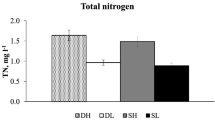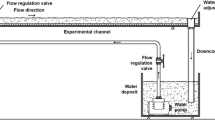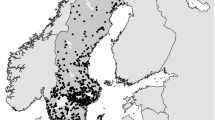Abstract
Eight experimental ditch mesocosms were used to study the effect of eutrophication over four years. The experimental ditches had a sand or clay bottom. The ditches were treated with additions of phosphorus, phosphorus and nitrogen, or without additions (controls). Oligochaetes were sampled by deploying trays with substratum for colonization over twenty weeks. Both the important variables phosphorus, nitrogen and oxygen as well as the oligochaete species and numbers are presented. The effects of nutrient additions on phosphorus, nitrogen and oxygen concentrations were described together with changes in oligochaete species composition and numbers. The results were further analyzed by redundancy analysis (RDA). In the clay-lined ditches nutrient addition coincided with fluctuation in oxygen concentration. The higher the nutrient addition levels the longer the period of oxygen depletion became. During oxygen depletion the number of oligochaetes was strongly reduced or even became zero. The low nutrient status of the sandy bed in the sand-lined ditches slowed down the rate of colonization. Only a few tubificids were collected. Eutrophication effects were only observed at the highest nutrient addition level. Considerable variation is attributed to stochastic factors in the sand-lined ditches. Whether oligochaete species were present was related to the length of the colonization period. The substratum composition and food together with oxygen regime decided whether they become more or less abundant in ditches. Large-scale mesocosm experiments require time to develop. Only after the first colonization period variables of species presences and abundances can be employed to detect changes associated with eutrophication. Oligochaetes can be used to measure colonization as well as eutrophication processes.
Similar content being viewed by others
References
Brinkhurst, R.O. & B.G.M. Jamieson, 1971. Aquatic Oligochaeta of the World. Oliver & Boyd, Edinburgh, 860 pp.
Brinkhurst, R.O. & D.G. Cook, 1974. Aquatic Earthworms (Annelida: Oligochaeta). In C.W. Hart, Jr. & S.L.H. Fuller. Pollution Ecology of Freshwater Invertebrates. Academic Press, New York 143–156.
Brinkhurst, R.O. & M.J. Austin, 1979. Assimilation by aquatic Oligochaeta. Int. Rev. ges. Hydrobiol. 64: 245–250.
Chapman, P. M., Farrell M.A. & Brinkhurst R.O., 1982. Relative tolerances of selected aquatic oligochaetes to individual pollutants and environmental factors. Aquatic Toxicol. 2: 47–67.
Chua, K.E. & R.O. Brinkhurst, 1973. Evidence of interspecific interactions in the respiration of tubificid oligochaetes. J. Fish. Res. Board Can. 30: 617–622.
Drent, J. & K. Kersting, 1992. Experimental ditches for ecotoxicological experiments and eutrophication research under natural conditions. War. Res. 27: 1497–1500.
Lafont, M., 1977. Les oligochetès et la détection des pollutions dans les cours d'eau. Eaux Ind. 17: 84–85.
Milbrink, G., 1973. On the use of indicator communities of Tubificidae and some Lumbriculidae in the assessment of water pollution in Swedish lakes. ZOON 1: 125–139.
Palmer, M.F., 1968. Aspects of the respiratory physiology of Tubifex tubifex in relation to its ecology. J. zool., Lond. 154: 463.
Pasteris, A., C. Bonacina & G. Bonomi, 1994. Observations on cohorts of Tubifex tubifex cultured at different food levels, using cellulose substrate. Hydrobiologia 278: 315–320.
Särkkä, J., 1987. The occurrence of oligochaetes in lake chains receiving pulp mill waste and their relation to eutrophication on the trophic scale. Hydrobiologia 155: 259–266.
Ter Braak, C.J.F., 1988. CANOCO — A FORTRAN program for canonical community ordination by [partial] [detrended] [canonical] correspondence analysis, principal component analysis and redundancy analysis (version 2.1). Report LWA-88–02. Agricultural Mathematics Group, Wageningen.
Ter Braak, C.J.F., 1990. Update notes: Canoco version 3.10. Agricultural Mathematics Group, Wageningen, The Netherlands.
Verdonschot, P.F.M., 1989. The role of oligochaetes in the management of waters. Hydrobiologia 180: 213–227.
Verdonschot, P.F.M. & C.J.F. Ter Braak, 1994. An experimental manipulation of oligochaete communities in mesocosms treated with chlorpyrifos or nutrient additions: multivariate analyses with Monte Carlo permutation tests. Hydrobiologia 278: 251–266.
Wachs, B., 1967. Die Oligochaeten Fauna der Fliessgewässer unter besonderer Berücksichtigung der Beziehungen zwischen der Tubificiden Besiedlung und dem Substrat. Arch. Hydrobiol. 63, 310.
Wiederholm, T., 1980. Use of benthos in lake monitoring. J. Wat. Pollut. Cont. Fed. 62, 537–547.
Author information
Authors and Affiliations
Rights and permissions
About this article
Cite this article
Verdonschot, P.F. Oligochaetes and eutrophication; an experiment over four years in outdoor mesocosms. Hydrobiologia 334, 169–183 (1996). https://doi.org/10.1007/BF00017367
Issue Date:
DOI: https://doi.org/10.1007/BF00017367




